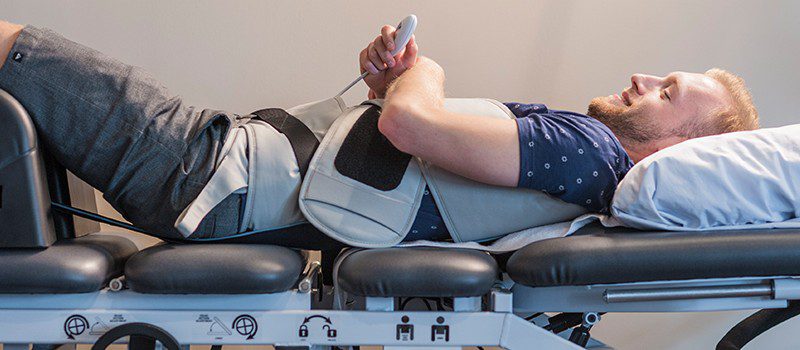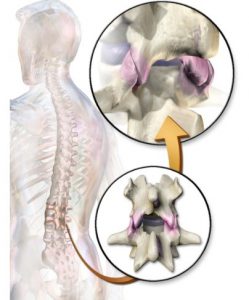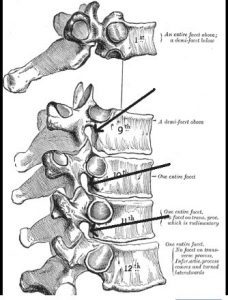
What Does Spinal Decompression Do?
Traction is the Treatment – Decompression is the Result
Traction is the process of drawing or pulling. When we utilize our hands or some mechanical device to apply this force to the spinal column it is called spinal traction. Decompression by Webster’s definition is “to release or reduce the physical pressure on something or to have the physical pressure released or reduced.”
It is here that we must make a distinction regarding the current use of the term spinal decompression. While the term is now used interchangeably, by pure definition the treatment is called spinal traction and the goal or result is spinal decompression. For the purposes of this article I will use both terms by the above definitions.
What exactly does it do? Spinal traction has the following proposed effects:
Mechanical Elongation of the Spine
As a result of the spinal traction, there is decompression. The term decompression in this context refers to mechanical separation of the vertebrae, which in turn:
- Stretches the spinal muscles
- Exerts mild tension on the ligaments and facet joint capsules
- Expands the intervertebral foramina
- Straightens the spinal curves
- Slides the facet joints
Facet Joint Mobilisation
The facet joints, (or zygapophysial joints, zygapophyseal, apophyseal, or Z-joints) are a set of synovial, plane joints between the articular processes of two adjacent vertebrae. There are two facet joints in each spinal motion segment.
The effects on the facet joints include a sliding or translation of the facet surfaces, distraction or a separation of the facet surfaces and compression or an approximation of the facet surfaces. While not empirically proven, this movement of the joints allows for an increase in range of motion and blood components at the joint. Teodorczyk-Injeyan et al (2006) found that mobilisation effected the levels of blood components, with a reduction in inflammatory proteins. Therefore, it was suggested that mobilisation could be a potential therapeutic modality to reduce inflammatory response – working as an anti-inflammatory mechanism. Teodorczyk-Injeyan, J., Injeyan, H., and Ruegg, R,. (2006). Spinal manipulative therapy reduces inflammatory cytokines but not substance P production in normal subjects. Journal of Manipulative and Physiological Therapeutics, Vol 29, 14–21

Figure 1Blausen.com staff (2014). “Medical gallery of Blausen Medical 2014”. WikiJournal of Medicine1(2)
Muscle Relaxation
There is a decrease in the pain produced from muscle guarding and spasm as well as greater vertebral separation as the muscles relax. Relaxation of muscles occurs through a neurophysiological process as stress/stimulation of joint mechanoreceptors and muscle sensory organs reduce the contraction and tension of muscles. Both effects are beneficial as far as relieving stress on the vertebral column.
Reduction of Pain
The following are proposed effects of traction that impacts the reduction of pain from spinal traction:
- There is an increased circulation because of the movement. This may reduce stricture from circulatory congestion. Improving this circulation appears to help decrease the concentration of painful chemical irritants in the joints.
- Separation of the vertebra increases (widens) the space where the nerve exits (the neuroforamen). This can reduce the pressure exerted on an impinged nerve root.
- Stretching of tight tissue can increase the motion at that segment reducing the pain from stress or strain on nociceptors (pain nerve endings).
- Tension on the facet joint capsule or distraction of the surfaces can release entrapment of the meniscus (cartilage between the joints).
- Stimulation of joint mechanoreceptors can gate (block) the transmission of painful stimuli at the brain stem level thereby providing pain relief.
- There can be neurophysiological inhibition of reflex muscle guarding and therefor reduction in myospasm.
Specific Effects on the Lumbar and Cervical Discs
- Create a negative intradiscal pressure to promote retraction or repositioning of the herniated or bulging disc material.
- Create a lower pressure in the disc that will cause an influx of healing nutrients and other substances into the disc. This can foster a better healing environment.
Is Spinal Traction – Decompression right for you?
As you can see, there are many ways that spinal traction can relieve pain in the spinal column. The key is still in determining whether the treatment is right for you. Its all about the right treatment for the right person, for the right condition at the right time. This depends on the diagnosis, stage of injury and most specifically a trial to determine that it is safe for you.
It is very important to know that not all spinal conditions respond to spinal traction / decompression. In fact, there are conditions that can be aggravated by it. Assessment by a qualified medically trained professional will identify contraindications (reasons to exclude the treatment).
In a future article we will explore what spinal conditions respond to spinal traction. If you are suffering back pain in Edmonton or St. Albert, please feel free to reach out to our St. Albert Physiotherapists or Edmonton Physiotherapists. Contact one of our offices to determine if this treatment is right for you.
In health, Grant Fedoruk
This information is not meant to replace the advice or treatment of a qualified physician or physiotherapist. It is meant for information only. Please seek an assessment and discuss your treatment options with your caregiver prior to making a decision about your treatment path.

